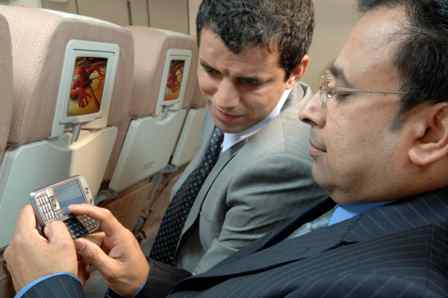Aeronautical engineers, airlines and in-flight entertainment and connectivity (IFE&C) suppliers descended on Boeing's Future of Flight museum last week to better understand airborne connectivity - and plan strategies for exploiting a technology which is grabbing headlines globally and offering a promising route to passengers' wallets.
This "meeting of the minds" by World Airline Entertainment Association (WAEA) members in Everett, Washington, highlighted the intense focus now being placed on passenger communications in the in-flight entertainment sector.
 |
|---|
© OnAirDemand is growing for Wi-Fi connectivity to be available in flight |
But despite all the fervour, one serious question remains - how much money will customers actually pay, on an ongoing basis, for in-flight connectivity?
"No one argues that connectivity represents a huge growth market for the IFE niche of aviation," says industry consultant and former WAEA executive director, Richard Owen. "Several industry sources say that connectivity alone could represent half of the value of the IFE segment in the next few years. That is trans-formational."
Owen adds: "Whether that growth turns out to be 25%, 50% or 100%, it is enticing new entrants into the marketplace. But make no mistake - this is not all new money being spent by the airlines."
Expenditure down
IFE&C consultancy IMDC last month reported that IFE&C hardware expenditure - including connectivity - will be down 20% in 2009 and will take several years to return to 2008 levels.
"If you like to think strategically and enjoy matching up current and new industry partners, this is a fun time to be at the table," says Owen. "It's a high-stakes game in which a few will win big financially and a few others will lose their shirts. Many more will pick up incremental pieces of business, while others will exit the market.
"I would argue that for the rest of us, there will be some great marketplace lessons regarding how customers respond to connectivity pricing."
What is certain, however, is that airlines from Asia, Europe, the Middle East and North America are adopting in-flight connectivity systems with a fervour never seen before, despite a global economic slump that is gripping even the most traditionally profitable carriers.
A newfound expectation by passengers to be connected at all times, coupled with technological advances in in-flight connectivity - and airlines' desire to create new ancillary revenue streams - are driving interest in systems ranging from Inmarsat-supported mobile phone connectivity to full-blown high-speed internet over Ku-band satellites.
In the USA, where cellphone calls are prohibited in flight, carriers are signing on for Aircell's air-to-ground (ATG)-based in-flight Wi-Fi system, Gogo. Delta Air Lines alone believes it will have more than 500 aircraft equipped with Gogo by the end of next year, says Delta manager onboard media Mike Henny, who says people in the USA are so used to having Wi-Fi available wherever they go that they have started taking airborne connectivity for granted.
Another Gogo customer, American Airlines, agrees with Delta's assessment. American's IFE systems engineering manager, Erik Miller, predicts that, just like on the ground, Wi-Fi will become ubiquitous in-flight.
Connectivity offering
Airbus/SITA joint venture OnAir is equally enthusiastic about prospects for its in-flight mobile connectivity offering. Chief executive Benoit Debains says the company has secured 21 commercial customers, "plus five or six VIP private customers, which are not often announced".
By the end of the year, the company expects to have close to 80 aircraft equipped "and we should reach 100,000 flights", Debains says.
For IFE&C industry players, this is "the sweet spot", says David Bruner, vice-president, global communications services for Panasonic Avionics, which is offering airlines a Ku-band satellite-based connectivity system.
Source: Flight International























